The different types of Bokken
A visit at the Horinouchi workshop
The Bokken is a tool. It can either faithfully represent a sword, be used for muscle training or, if it is very light, become an instrument in order to work on precision. Some schools even consider the Bokken as weapon itself and study it as such. In Aikido, Kendo or Iaido, relatively conventional Bokken are used, compared to some schools of Kenjutsu, Koryu and Kobudo, for which specific weapons are chosen, especially to support the physical development and the specific techniques of the school. Since 1923, the Horinouchi workshop takes pride in keeping a copy of every manufactured weapon. Even though the exact number of the available models is unclear, there are certainly over a hundred types displayed in the small private museum of the workshop.

Private museum of the Horinouchi workshop
The Horinouchi Workshop
Founded by master Horinouchi Noboru in 1923, his workforce varied from one to more than 30 artisans during the golden age. Soon recognized as highly skilled craftsman, the Japanese army as well as the special unit for the railways in Manchuria (during the Japanese invasion before World War 2) can be counted among his clients. It was not until 1967 that the company "Horinouchi Noboru Seisakujo" was founded, primarily to allow investments. In 1984, shortly after the creation of an association for protecting craftsmen in Japan, Horinouchi Noboru received the title of "Dento Kogeishi". Today, the company is run by his son, has a dozen employees and produces about 250 pieces a day.

It was also the Horinouchi workshop who theorized the fabrication of the Bokken. Most technical terms used to define the various forms (like Kantogata, Kendogata etc. for the Kissaki for example) come from this atelier.
During our visit, master Horinouchi also explained to us, that there were even variations between different Dojos of the same school. For example the Kashima Shin Ryu Bokken is not identical if ordered from the main Dojo of the Shiseikan or from members of other Dojos.

Some pieces of the collection of the atelier.

Several rewards received by the workshop and its craftsmen.
The shape of the Bokken
The vast majority of the Bokken produced today is known as "standard/classic" or "premium". The Sori (curvature) is identical, the weight does not vary much and only the finishes of the Tsukagashira (butt), the Mine (spine) and the Kissaki (tip) are slightly different. These so called "classic" Bokken are mainly used in Kendo, Aikido and sometimes also in Iaido.
There are actually more than 100 different Bokken types still used today, varying in thickness, weight, length, curvature, etc. Each traditional sword school (Yagyu Shinkage, Keishi Ryu, Kashima, Katori, etc.) has its own model, designed to best match the characteristics developed through the practice of the Kata of each school. Some schools even adapt the length and weight of the weapon to the practitioner, what obviously complicates the work of the artisan.
Even though the manufacture of a Bokken is relatively quick, it requires a full understanding of the object and expertise in the handling of the tools. Starting with the thickness, the finishing of the Tsuka and the Kissaki, the position of the Shinogi (blade ridge), the shape of the Mine and last but not least the curvature: The Bokken is so complex in its manufacture, that the masters of Kyushu, all knowing each other, are able to determine the craftsman of the weapon by simply analyzing its characteristics.
In this article we will present the most important elements, namely the various types of th Sori (curvature) the Kissaki (tip), the Tsukagashira (butt) and the Mine (spine).
The curvature (Sori)

The Sori or curvature is probably the most important element of the Bokken apart from its size, weight and balance. Combined with these factors, the characteristic of a Bokken is greatly influenced by the position of the Sori. (The pronunciation "-zori" instead of "Sori" will be used, because the word is placed second in an expression.) The Sori (the highest point of the curvature) is usually placed at the center, depending on the craftsman. So the standard is a "Kyo Zori" or "centered curve". However, the Koryu Bokken (stylized) can have all these types of Sori: Suguhazori, Kyozori, Koshizori or Sakizori.
Kissaki (tip/point)

The Kissaki or tip has, unlike the curvature, not a big impact on the behavior of the Bokken during the movement. Its role is mainly aesthetic. The classic Bokken exists with a Shokissaki" (small tip), a Daikissaki (large tip) or even with a "Tokudaikissaki" (very large tip). However, the characteristics of the Bokken will be slightly modified in case of a flat or beveled Kissaki, increasing the weight at the tip of the Bokken and thus shifting the equilibrium towards the tip.
The Aikido Iwama Ryu Bokken is an excellent example of a heavy Bokken designed to develop strength, with the equilibrium significantly pushed toward the tip due to its flat Kissaki - or should we say "the absence of the Kissaki". Other finishes existing are the "Kendogata", seen mainly on the ancient Kendo Bokken, further the "Kantogata" (Kanto-style, Tokyo area) and finally the "Unokubi", which is quite rare but found on certain Koryu Bokken (stylized).
Mine (back of the blade/general shape)

There are mainly four types of Mine (general shape of the spine). The shapes Hiramineand Kenmine have little impact on the behavior of the Bokken, however the Marumineand Gyo no Mine types significantly alter the weight distribution of the Bokken. These types aretypically lighter. There is also an intermediate form between the Hiramine and the Marumine, where only the leftand right side blade ridges are rounded with a top remaining flat as for the Hiramine finish. This form isparticularly used for the first type of the Iwama Ryu (Takemusu) Bokken, nowadays replaced by a classic Hiramine. The classic Bokken have a Hiramine or a Kenmine finish.
Tsukagashira (pommel/butt ending)

The expression Tsukagashira is used to describe the form of the pommel (butt). There are only two types Tsukagashira (flat) or Hanmaru (rounded). Used mainly for aesthetic reasons (most Koryu Bokken have a Tsukagashira) it can be more comfortable to practice with a Bokken with a rounded pommel.
Atsumi (thickness)
Even though many variations are possible, there are three basic categories regarding the thickness: The thin type Bokken, the Yagyu Ryu Bokken. The standard type Bokken, representing the majority of the models and the
heavy weight types e.g. the Keishi Ryu Bokken.
There is a limit for the thinness of a Bokken, especially to prevent the Bokken from twisting (when exposed to temperature changes and humidity) and to keep a certain stability. But there is almost no limit for its thickness.
Beyond a certain weight the Bokken falls into the category Suburito of course. They can weight up to 50 kg and are used in certain schools for muscle training.
Tsuba (guard)/optional

Usually, the Tsuba, if used, are made from plastic or leather, but in certain cases they can also be made from wood. In order to fix the protection, it is necessary that the Bokken was designed for that purpose,which means that there is a small indentation at the top of the handle to block the Tsuba.
Finishes without this demarcation between the handle and the blade are called "Tsubanashi" or "Ryakushiki" Bokken. Besides the classic shaped Bokken, talking about Koryu (Kenjutsu), this is the most common finish.
Hi, Bohi, or (groove)/optional

All standard Bokken can be provided with a groove. Spanning almost the whole blade, the groove has two functions. On one hand, it creates a typical sound well known by Iaido practitioners and can on the other andsignificantly reduce the weight of the Bokken. Because of the groove and therefore the resemblance to the Iaito (and also the Shinken), this finish is mainly chosen by Iaido practitioners. Apart from the Bokken specially designed for the Iaido practice, there are no Koryu Bokken made with groove.
Interview with Matsuzaki Yoshiaki Published in 2017
In depth video interview, published 3 years later.

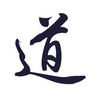
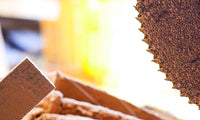
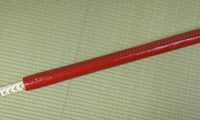
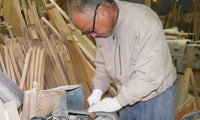
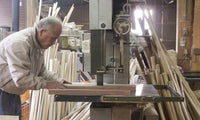
4 comments - Different types of Bokken, visit at the Horinouchi workshop
Great article!
I’m interested in bokken prices.
In reply to Joe Beckham.
Thank you very much for your comment.
For pricing, please check out our website SeidoShop.com
Thanks for all this detailed information, it’s great to have access to more knowledge about the weapon I like the most.